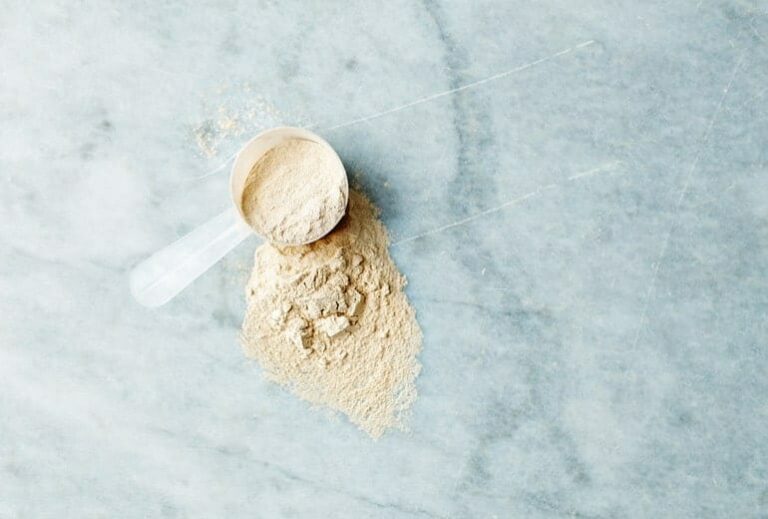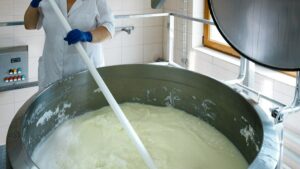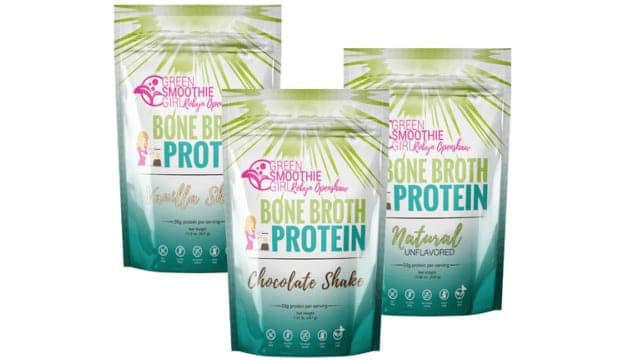Whey Protein Is Bad For You, Here’s What You Need to Know

Why should you avoid whey protein?
As an advocate for a primarily plant-based diet, I can’t count how many times I’ve been asked, “But what about protein?”
I’ve written about the epic obsession Americans have with protein intake. It’s true some people do feel better when they get more protein in their diet. If you’re one of those who worries about not getting “enough” protein, you need to know why whey protein is bad for you.
Why Is Whey Protein Bad? | What You Should Know
In this article:
- Why Is Whey Protein Bad for You? It's a By-product (Throwaway)
- Two Better Alternatives
- A Protein Punch from Plants
- Our Superfood Protein Meal
- Bone Broth Protein
- Green Smoothie Girl Protein Powder
Why Is Whey Protein Bad for You? It's a By-product (Throwaway)

Whey is a bi-product of dairy processing, originally not even considered a food, and is heavily processed itself.
Whey is bad because it wasn't originally considered to be food. Those protein supplements were by-products of dairy processing. Then, the industry discovered they could gather that throwaway product, dry it, and market it as a nutrition product by touting its high protein content. (Which is probably the only good thing you can say about it.)
It’s a manufacturer’s dream—repurposing a waste by-product to increase profit on the same process!
Through great marketing, and because the product has such a low cost for the manufacturer, Americans now spend billions of dollars a year on whey protein supplements.
But just because they’re selling us a lot of it doesn’t make it good for you!
1. Whey Protein Is Overly Processed
Whey protein goes through many refining stages—sometimes up to 14 different processes—before it’s served up to you in a bag or a bar.
It’s a highly refined food, without any real redeeming qualities, and we already know that processing any food causes the body to react negatively in a variety of ways.
Whey protein is also devoid of fiber, low in most micronutrients, and quite acidic. It may cause the human body to react by producing mucus, as it does to flush out anything it doesn’t recognize as nutrition.
Many whey protein powders even contain food dyes like Yellow #5 (Tartrazine), which scientists have proven can negatively affect organs like the liver and kidneys, even at low doses.1
2. Whey Protein Is Full of Hormones, Steroids, and Antibiotics
Because whey is made from cow’s milk, consumers of it are getting high exposure to steroids, hormones, and antibiotics fed to the cow.
Most whey proteins come from conventional cow’s milk. Now, some marketers are differentiating themselves by claiming their whey protein is from cows in New Zealand, from cows that aren’t fed with rBST hormone, or from cows that are organic.
Well, that’s certainly better than the hormone-, antibiotic-, and steroid-laden stuff most manufacturers sell, right?
Wrong. No matter what the source is, any cow’s milk (and therefore, whey) still has all the problematic natural bovine hormones and proteins (different from those in human milk) that have been shown to cause inflammation, flare up autoimmune diseases, trigger allergies, and possibly wreak havoc to insulin long term.2
3. Whey Protein Is Being Linked to Cancer and Heart Diseases
Another answer to the question “Why is whey protein bad?” is these milk proteins have also been linked to cancer and heart diseases by The China Study, the biggest piece of nutrition research ever undertaken.3
You may be familiar with the findings by those Oxford and Cornell researchers who also documented that subjects who didn’t eat milk proteins had much lower rates of cancer and other diseases.
Two Better Alternatives
Don’t get me wrong. I love protein. Who doesn’t want to maintain muscle growth and strength? Who doesn’t want to burn fat? Who doesn’t want to slow down the impact on their blood sugar and decrease the insulin reaction of, for example, the fruit sugars in their green smoothie?
Protein powder is just so convenient for all those purposes and more. I use it myself. But let’s take whey protein off the table, shall we?
In fact, over the years, I’ve also rejected countless other protein powders as too processed, too junky, too gimmicky, or from dubious sources.
It’s why I’ve ended up making my own protein powders. I know exactly what’s in them, what the processes are, and who has handled them.
We just reformulated our plant-based protein powders to make them even more nutritious!
A Protein Punch from Plants
Our NEW and IMPROVED Organic Superfood Plant Protein Meal is an amazing blend of plant proteins combined with high-nutrient greens like kale and spinach and superfoods like spirulina and sachi inchi.
The Chocolate and Vanilla Kiss are naturally sweetened with a bit of herbal stevia.
No matter what flavor you choose, this plant protein powder is a fantastic addition to your green smoothie, or you can add it to water for an easy, yummy nutritious meal or snack.
How wonderful would it be to reach for a product with an ingredient list similar to what you grow in your garden, rather than one you have to Google to understand?
Bone Broth Protein
Are you ready for the cleanest, most delicious grass-fed bone broth protein anywhere?
I don't eat very many animal products, but the collagen-rich bone broth is a whole food that may be a missing link even for people like me who eat mostly plants.
The "skin" of your intestinal tract is huge; it would cover a tennis court. And, nothing is better for the health of your skin than a clean version of bone broth. It's a magic elixir not only for the skin you show the world but for that internal "skin" as well.
The collagen in bone broth helps repair and maintain joints and tissues, while the gelatin and essential amino acids “heal and seal” your gut, promote bone, hair, and nail health, and quiet inflammation.
But, it's a hassle to find grass-fed beef bones and boil it for hours. I tried it for a while, and it was a stinky drag.
Green Smoothie Girl Protein Powder

Our Bone Broth Protein Powder comes in three delicious flavors: Natural, Chocolate Shake, and Vanilla Shake
I’m thrilled to bring you our GSG Bone Broth Protein powder in Natural, Chocolate Shake, and Vanilla Shake flavors!
The Natural version is pure bone broth protein with nothing added, and so neutral in taste that you can add protein to any food or beverage without adding any flavor. It goes down easily by itself, too, in hot or cold water.
But, let me tell you about the Vanilla Shake and Chocolate Shake flavors.
They are sweetened with all-natural monk fruit, and these blends are so unbelievably yummy that we had to name them “shakes” because they literally taste like that.
They blend easily and are fabulous in just plain water, cold for a refreshing “shake,” or hot for a soothing, cozy “hot cocoa,” like a treat at bedtime. Even kids will ask for more!
Make the Best Choice for Your Protein Powder
Now that you know the answers to the intriguing question “Why is whey protein bad?” you’ll say “No way!” to whey already. You also need healthy shortcuts and clean protein sources. I pack a bag of both kinds of GreenSmoothieGirl protein powder to get me through long flights and trips where I’m on the move.
If I feel like a meal I’m eating is too high in carbs (carbs are not bad by the way!), I just add some of any of these proteins to water, shake it up, and drink it first.
Keep some in your purse or travel bag along with a blender bottle. This way, you’ll never have to be hungry, and you’ll always get outstanding nutrition.
There are much better, healthier options than whey protein.
Up Next: A Review of John Robbins’ Epic Work, The Food Revolution

Disclosure: This post may contain affiliate links that help support the GSG mission without costing you extra. I recommend only companies and products that I use myself.
Sources:
- Amin, K A, et al. “Effect of Food Azo Dyes Tartrazine and Carmoisine on Biochemical Parameters Related to Renal, Hepatic Function and Oxidative Stress Biomarkers in Young Male Rats.” Food and Chemical Toxicology : an International Journal Published for the British Industrial Biological Research Association, U.S. National Library of Medicine, Oct. 2010, www.ncbi.nlm.nih.gov/pubmed/20678534.
- Gottlieb, Scott. “Early Exposure to Cows' Milk Raises Risk of Diabetes in High Risk Children.” BMJ : British Medical Journal, BMJ Publishing Group Ltd, 28 Oct. 2000, www.ncbi.nlm.nih.gov/pmc/articles/PMC1173447/.
- Campbell, T C, et al. “Diet, Lifestyle, and the Etiology of Coronary Artery Disease: the Cornell China Study.” The American Journal of Cardiology, U.S. National Library of Medicine, 26 Nov. 1998, www.ncbi.nlm.nih.gov/pubmed/9860369.
Editor’s Note – This post was originally published on May 16, 2017, and has been updated for quality and relevancy.
Posted in: Green Smoothies
















Great info as always – by chance is there a ‘variety’ pack with all the flavors? Trying to keep the ‘family’ happy 😀
Good article -read it with interest as I had just had a debate with a doctor friend who was advocating whey protein. One quibble though, you state ‘Over time, this mucousy situation causes an increasingly acidic climate’ -surely its the other way around ?
I am so glad you posted this. I gave up whey about a week ago after having the worse stomach ache of my life! I had always heard that it was good for you, but it always made me feel bad after ingesting it. I don’t know why I continued taking it, but after that last attack…no more! Thanks for confirming my decision.
This post was extremely enlightening as to what happens in the process of typical whey products out there and I am certainly not defending it.
However, denatured, cold pressed whey from grass-fed cows (no sugar of course, or other chemicals…yes there are a few brands out there!) contains high levels of the pre-curser amino acids to glutathione, the master anti-oxident. I don’t know if the plant based ones do… can anyone give me some info on this?
I intend to read the China study…it’s on my summer to do list. In all fairness, I’ve only read excerpts and find many people referencing the study. However, it seems some of my favorite researchers in health and nutrition question the validity of the study. The researcher below brings up the point that the children from the well-fed families were eating a lot of peanut butter with high aflatoxin amounts (he says could have initiated the cancer). Science has proved afla and other mycotoxins are cancer causing.
https://www.cholesterol-and-health.com/China-Study.html
Any thoughts on these?
In Dr. Campbell’s lab experiments, the rats seeded with aflatoxin that were on vegetable diets did NOT develop cancer but the one’s fed milk protien (also seeded with the toxin) DID develop cancer. He explains it very clearly in the book. Hopefully you can read it soon and clear a lot of this up. However, I understand what you mean about conflicting information and confusion. Both sides offer supporting research so in my opinion, the bottom line is , we CHOOSE whom we believe. I choose the one that makes the most sense overall and that seems to be best supported by God’s original design. Look at what He put in the garden!
That’s right, Kathy. 🙂
Let belief be reserved for what we do not KNOW. However, when we have the fruit of KNOWLEDGE we can just as well apply our knowledge to living, thus gaining wisdom. There are enough studies and research to point to the conclusion that raw dairy IS how God made it. The research of Mary Enig on “The Case for Raw Milk,” Dr. Weston Price’s timeless research as well as Dr. Pottinger’s research clearly refute Dr. Campbell’s findings. Like Eileen below says, Chris Masterjohn and Denise Minger have recently compiled research that again points to the protective qualities of animal and raw milk protein.
I like what Dr. Mercola writes on this topic: eat for your nutritional body type. I come from Croatia where my ancestors date back to the ancient Sumerians. We’ve been living off of raw yogurt, raw milk, raw cheese and pasture raised animals for generations. Both my grandparents lived into their eighties on this diet with no diabetes, heart problems, skin problems or any other such modern epidemics as we have now. They worked on their farm literally until the very week before they died.
After eating raw for only two weeks i developed such pain in my gums and teeth. I switched back to a variation of Gerson eating with Price’s eating (which is nothing more than how MY FAMILY has been eating for generations… no sugar (it was too expensive), low carb, raw milk and COOKED veggies with every meal including bone broth and animal fat… and my gum inflammation has gone done significantly with no pain since then. I suspect it was the anti-nutrients in the uncooked veggies that caused harm to ME specifically… some people still can absorb the micro-nutrients of a raw diet: I am not one of them. Many people, say maybe Islanders, couldn’t tolerate what we farm folks eat, and perhaps do better on fish and nut-fats. In this case, I believe that is the way it is because I do not know.
So yes Kathy, I totally agree with you. We definitely choose whom we believe. However, for me it’s not who to believe but what I know as truth. I appreciate the breakdown of the study and actually have the China Study Cookbook on hold as well as The China Study on hold at the library. I am looking forward to reading the ONE study that everybody seems to be citing as the reason to stay away from dairy. Certainly, I must be missing something???
Robyn, I’m an agnostic about whey protein. You’re absolutely right: it is highly processed, and it is a byproduct. That doesn’t necessarily mean it’s bad, however. You’ve also conflated two distinct variables: you reference the China study’s work on casein protein, which is different from whey protein. Also, some outstanding researchers have pretty much debunked the validity of the China Study. Denise Minger has done a thorough job, as has Chris Masterjohn.
I MIX the Superfood Protein Meal with the Chocolate Bone Broth. Mmmmm… so good!
Robyn, just wondering what your thoughts are about green tea extract and the word of wisdom.
Question: what is the process for making bone broth powder? Is it simply dehydration? Seems like it could have a lot of steps, potentially, like poor quality whey protein powders.
I agree that most whey protein is junk. I’ve used one called Vital Choice (I think) in the past that is cold-processed and supposedly has the same properties as raw milk.
Is there a chicken or turkey option in future product plans?